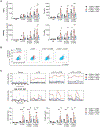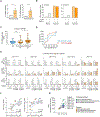Diapedesis-Induced Integrin Signaling via LFA-1 Facilitates Tissue Immunity by Inducing Intrinsic Complement C3 Expression in Immune Cells
- PMID: 32187519
- PMCID: PMC7111494
- DOI: 10.1016/j.immuni.2020.02.006
Diapedesis-Induced Integrin Signaling via LFA-1 Facilitates Tissue Immunity by Inducing Intrinsic Complement C3 Expression in Immune Cells
Abstract
Intrinsic complement C3 activity is integral to human T helper type 1 (Th1) and cytotoxic T cell responses. Increased or decreased intracellular C3 results in autoimmunity and infections, respectively. The mechanisms regulating intracellular C3 expression remain undefined. We identified complement, including C3, as among the most significantly enriched biological pathway in tissue-occupying cells. We generated C3-reporter mice and confirmed that C3 expression was a defining feature of tissue-immune cells, including T cells and monocytes, occurred during transendothelial diapedesis, and depended on integrin lymphocyte-function-associated antigen 1 (LFA-1) signals. Immune cells from patients with leukocyte adhesion deficiency type 1 (LAD-1) had reduced C3 transcripts and diminished effector activities, which could be rescued proportionally by intracellular C3 provision. Conversely, increased C3 expression by T cells from arthritis patients correlated with disease severity. Our study defines integrins as key controllers of intracellular complement, demonstrates that perturbations in the LFA-1-C3-axis contribute to primary immunodeficiency, and identifies intracellular C3 as biomarker of severity in autoimmunity.
Keywords: LAD-1; LFA-1; T cells; Th1 cells; autoimmunity; biomarker; complosome; integrins; intracellular complement; lymphocyte adhesion deficiency type 1; metabolism.
Copyright © 2020 Elsevier Inc. All rights reserved.
Conflict of interest statement
Declaration of Interests The authors declare no competing interests.
Figures






Similar articles
-
Different roles for LFA-1 and VLA-4 integrins in T-B-cell interactions in vivo.Immunology. 1999 Jul;97(3):438-46. doi: 10.1046/j.1365-2567.1999.00794.x. Immunology. 1999. PMID: 10447765 Free PMC article.
-
CD47 plays a critical role in T-cell recruitment by regulation of LFA-1 and VLA-4 integrin adhesive functions.Mol Biol Cell. 2013 Nov;24(21):3358-68. doi: 10.1091/mbc.E13-01-0063. Epub 2013 Sep 4. Mol Biol Cell. 2013. PMID: 24006483 Free PMC article.
-
Effects of I domain deletion on the function of the beta2 integrin lymphocyte function-associated antigen-1.Mol Biol Cell. 2000 Feb;11(2):677-90. doi: 10.1091/mbc.11.2.677. Mol Biol Cell. 2000. PMID: 10679023 Free PMC article.
-
Complement Has Brains-Do Intracellular Complement and Immunometabolism Cooperate in Tissue Homeostasis and Behavior?Front Immunol. 2021 Feb 25;12:629986. doi: 10.3389/fimmu.2021.629986. eCollection 2021. Front Immunol. 2021. PMID: 33717157 Free PMC article. Review.
-
Not Just an Adhesion Molecule: LFA-1 Contact Tunes the T Lymphocyte Program.J Immunol. 2017 Aug 15;199(4):1213-1221. doi: 10.4049/jimmunol.1700495. J Immunol. 2017. PMID: 28784685 Review.
Cited by
-
Cell type specific gene expression profiling reveals a role for complement component C3 in neutrophil responses to tissue damage.Sci Rep. 2020 Sep 24;10(1):15716. doi: 10.1038/s41598-020-72750-9. Sci Rep. 2020. PMID: 32973200 Free PMC article.
-
Gut complement induced by the microbiota combats pathogens and spares commensals.Cell. 2024 Feb 15;187(4):897-913.e18. doi: 10.1016/j.cell.2023.12.036. Epub 2024 Jan 26. Cell. 2024. PMID: 38280374 Free PMC article.
-
Global C3 lowering in adulthood protects against hippocampal dysfunction and cognitive impairment in aged mice.Res Sq [Preprint]. 2025 Jun 23:rs.3.rs-6924607. doi: 10.21203/rs.3.rs-6924607/v1. Res Sq. 2025. PMID: 40678242 Free PMC article. Preprint.
-
Intracellular complement: Evidence, definitions, controversies, and solutions.Immunol Rev. 2023 Jan;313(1):104-119. doi: 10.1111/imr.13135. Epub 2022 Sep 13. Immunol Rev. 2023. PMID: 36100972 Free PMC article. Review.
-
The role of complement in arterial hypertension and hypertensive end organ damage.Br J Pharmacol. 2021 Jul;178(14):2849-2862. doi: 10.1111/bph.15171. Epub 2020 Aug 19. Br J Pharmacol. 2021. PMID: 32585035 Free PMC article. Review.
References
-
- Abraham C, Griffith J, and Miller J (1999). The dependence for leukocyte function-associated antigen-1/ICAM-1 interactions in T cell activation cannot be overcome by expression of high density TCR ligand. J Immunol 162, 4399–4405. - PubMed
Publication types
MeSH terms
Substances
Grants and funding
- ZIA HL006222/ImNIH/Intramural NIH HHS/United States
- 097261/Z/11/Z/WT_/Wellcome Trust/United Kingdom
- K22 HL125593/HL/NHLBI NIH HHS/United States
- 102932/Z/13/Z/WT_/Wellcome Trust/United Kingdom
- 21226/VAC_/Versus Arthritis/United Kingdom
- R44 DK075149/DK/NIDDK NIH HHS/United States
- R43 DK075149/DK/NIDDK NIH HHS/United States
- MR/M004600/1/MRC_/Medical Research Council/United Kingdom
- ZIA DK075149/ImNIH/Intramural NIH HHS/United States
- DH_/Department of Health/United Kingdom
- MR/J006742/1/MRC_/Medical Research Council/United Kingdom
- WT_/Wellcome Trust/United Kingdom
- ZIA HL006223/ImNIH/Intramural NIH HHS/United States
LinkOut - more resources
Full Text Sources
Molecular Biology Databases
Miscellaneous

